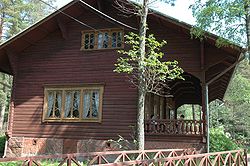
Langinkoski
Encyclopedia

Kymi River
Kymi river is a river in Finland. It begins from the lake Päijänne, flows through the provinces of Päijät-Häme, Uusimaa and Kymenlaakso and discharges into the Gulf of Finland. River passes the towns of Heinola and Kouvola...
in Kotka
Kotka
Kotka is a town and municipality of Finland. Its former name is Rochensalm.Kotka is located on the coast of the Gulf of Finland at the mouth of Kymi River and it is part of the Kymenlaakso region in southern Finland. The municipality has a population of and covers an area of of which is water....
, Finland
Finland
Finland , officially the Republic of Finland, is a Nordic country situated in the Fennoscandian region of Northern Europe. It is bordered by Sweden in the west, Norway in the north and Russia in the east, while Estonia lies to its south across the Gulf of Finland.Around 5.4 million people reside...
.
Imperial fishing lodge
Alexander III of RussiaAlexander III of Russia
Alexander Alexandrovich Romanov , historically remembered as Alexander III or Alexander the Peacemaker reigned as Emperor of Russia from until his death on .-Disposition:...
(who ruled the Grand Duchy of Finland
Grand Duchy of Finland
The Grand Duchy of Finland was the predecessor state of modern Finland. It existed 1809–1917 as part of the Russian Empire and was ruled by the Russian czar as Grand Prince.- History :...
as part of the Russian Empire
Russian Empire
The Russian Empire was a state that existed from 1721 until the Russian Revolution of 1917. It was the successor to the Tsardom of Russia and the predecessor of the Soviet Union...
) had a very small manor
Manor house
A manor house is a country house that historically formed the administrative centre of a manor, the lowest unit of territorial organisation in the feudal system in Europe. The term is applied to country houses that belonged to the gentry and other grand stately homes...
or a medium sized log house built there, between the branches of the Kymi river. He would take relatively rustic vacations there, along with his family. His wife the empress Marie Feodorovna (née Dagmar of Denmark) enjoyed cooking while he fished or split wood. The log house is now a museum.
Alexander III, and Dagmar had heard about the good salmon fishing at Langinkoski, so in the summer of 1880 they arrived at Langinkoski to watch the salmon fishing. They also took a liking to the beautiful river scenery and promised to return.
Some years later they did return to Langinkoski. They said that they would like to have a little fishing hut on the banks of the river.
The senate of the Grand Duchy of Finland took measures to have a villa built for the sovereign and his family on the very banks of the Langinkoski rapids. The lodge was designed by architect Magnus Schjerfbeck and the interior decorating was planned by architect Jac. Ahrenberg.
The construction of the lodge was begun in the summer of 1888. The imperial couple were so interested in their summer house in Finland that they came to watch the progress of the project. Along with them came their youngest children, grand duke Michael, 10, and grand duchess Olga, 6.
The interior decorating of the lodge was almost totally designed and manufactured in Finland.
The pieces of furniture in the sitting room were manufactured by local cabinet-makers, the textiles by Tampella in Tampere, the chinaware by Arabia in Helsinki, the axe by Billnäs, the wine and drinking glasses by Karhula Glassworks and the kitchen stove by Högfors; all well-known firms which still exist.
At their Langinkoski lodge the imperial family led a very simple life. The emperor was very fond of children and he took his youngest children for outings in the surroundings. The members of the imperial family used simple clothing and had uncomplicated food to eat.
Empress Marie Feodorovna knew how to cook and at Langinkoski she had an opportunity of devoting herself to that hobby. It is known also that she did not like washing the dishes.
Some years ago a photograph taken at Langinkoski was found in the Russian State Archives in St. Petersburg. The picture shows empress Marie Feodorovna sitting on the kitchen porch busying herself with cooking. The young officer to the right is Grand Duke Georgij, her second youngest son. This probably was his only visit to Langinkoski. He had caught tuberculosis and the doctors had recommended for him to live in a mountain climate. He lived in the Caucasus and died there at the age of 28 years.
When Finland became independent in 1917 the imperial fishing lodge was taken over by the Finnish government, but it was left without maintenance. Pieces of furniture were removed to unknown destinations and the lodge began to deteriorate.
Private individuals saved the lodge for posterity by establishing an association with the intention of turning the lodge into a museum. Their second attempt to get the government's permission for their project met with success and in 1933 the museum was opened. This very day the association, Langinkoski Museum Society, acts as museum operator under a contract with the government and under the supervision of the National Board of Antiquities.
In the 1920s the beds of the emperor and the empress had been taken away to an unknown place. As a result of many years of detective work by the Museum Society the beds were traced at Kultaranta, the summer residence of the president of Finland!
There they were placed in the guest rooms. Well, in 1956 they were returned to Langinkoski where they can be seen upstairs in the bedroom of the imperial couple."

